#Klondike Gold Rush National Historical Park
Text
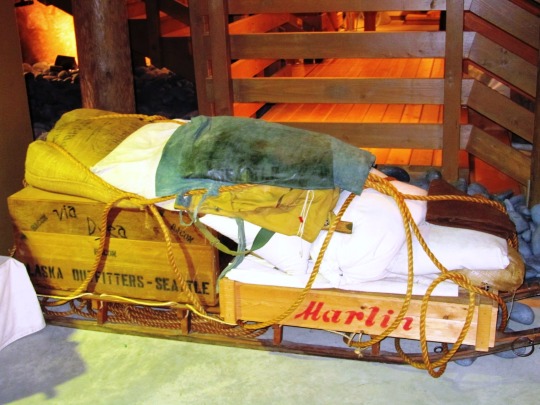

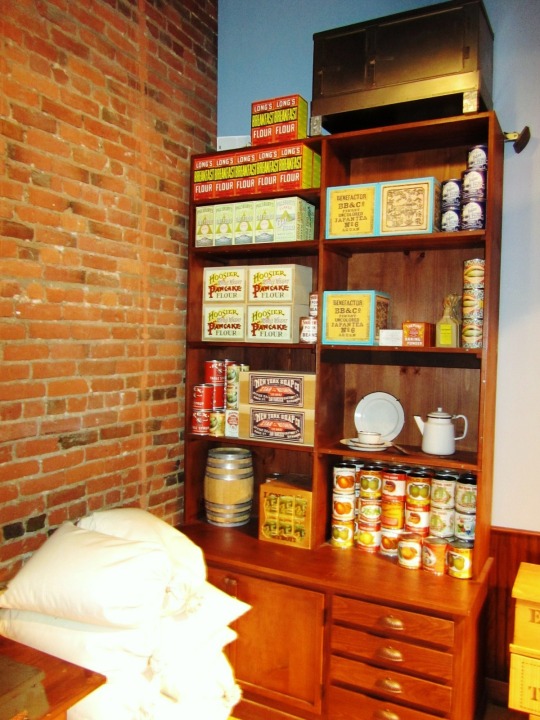



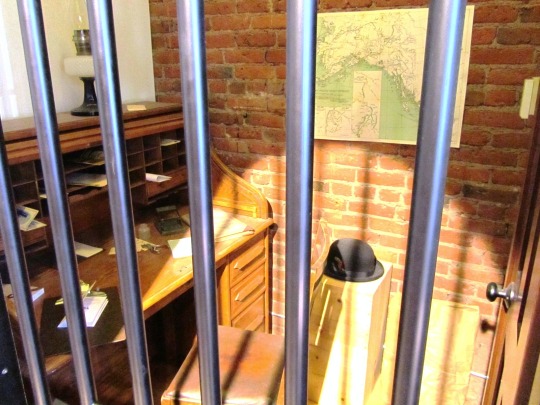

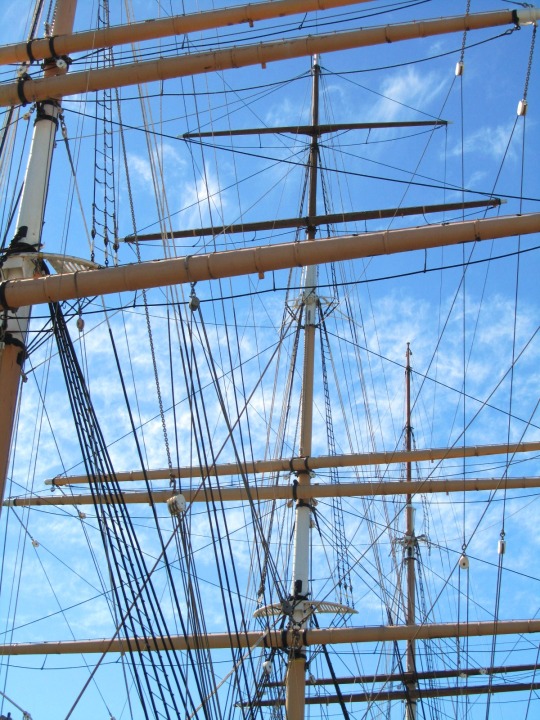
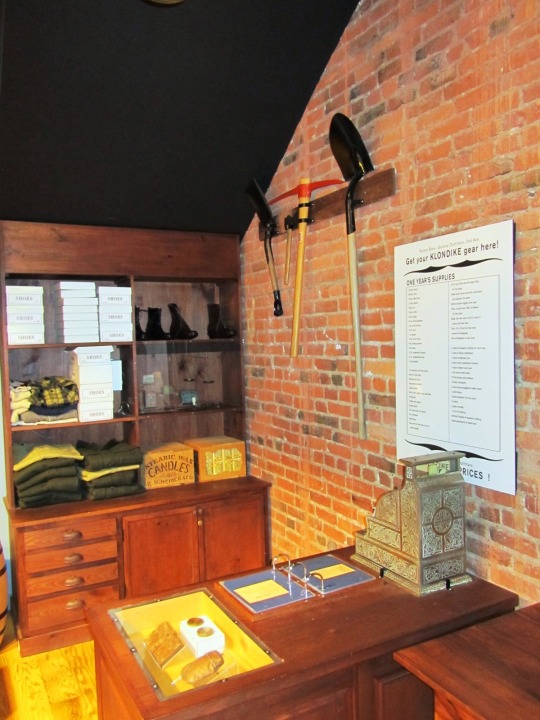

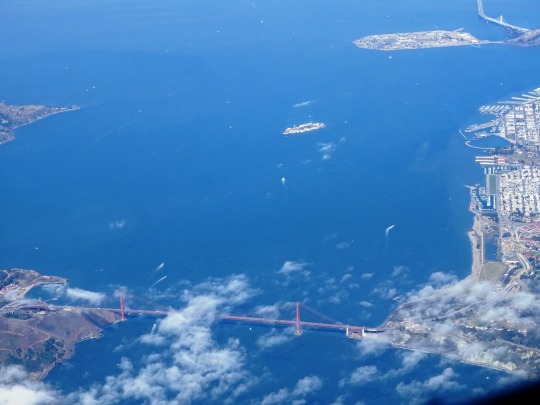

In the Klondike stampede, an estimated 100,000 people tried to reach the Klondike goldfields, of whom only around 30,000 to 40,000 eventually did. It formed the height of the Klondike gold rush from the summer of 1897 until the summer of 1898. It began on July 15, 1897 in San Francisco and was spurred further two days later in Seattle, when the first of the early prospectors returned from the Klondike, bringing with them large amounts of gold on the ships Excelsior and Portland.
#Klondike gold rush#15 July 1897#started#USA#San Francisco#Seattle#Washington#summer 2012#San Francisco Maritime National Historical Park#San Francisco Bay#Golden Gate Bridge#2022#travel#original photography#vacation#tourist attraction#landmark#cityscape#architecture#Klondike Gold Rush - Seattle Unit National Historical Park#Pacific Ocean#California
11 notes
·
View notes
Text
Sunday 9th October cont’d
We then went to the ‘Gold Rush National Historic Park, that is actually in a building. It was a display about the Klondike Goldrush in the early 1890’s and Seattle’s part in that. A large proportion of those involved started their journey in Seattle and either travelled by ship through the inside passage to Skagway or nearby Dyea.and then travelled overland, or the richer folk went by ship all the way to St Michaels in western Alaska and a shorter journey. 300,000 people attempted to reach the Klondike but only 20000 succeeded but only 3000 made any appreciable money out of it. The displays linked in with the displays we saw in Skagway.
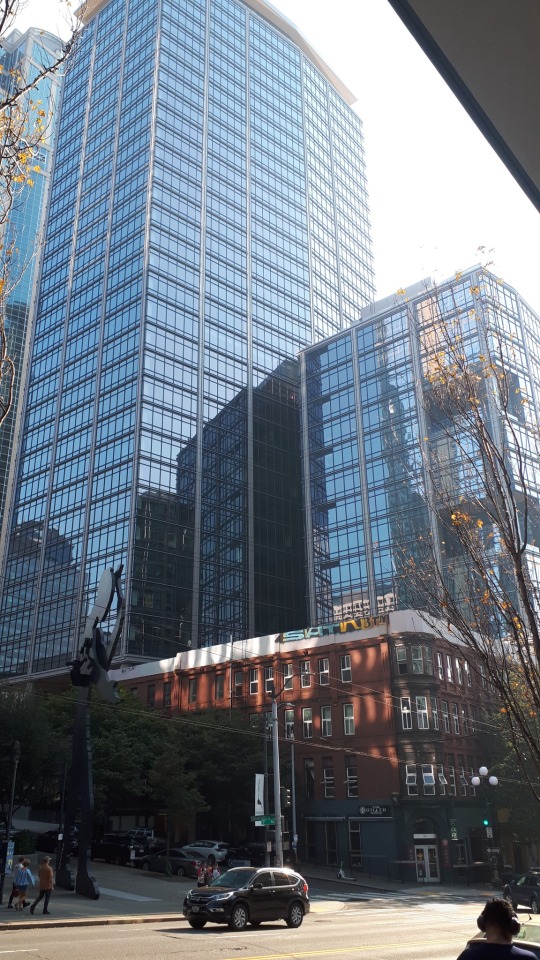
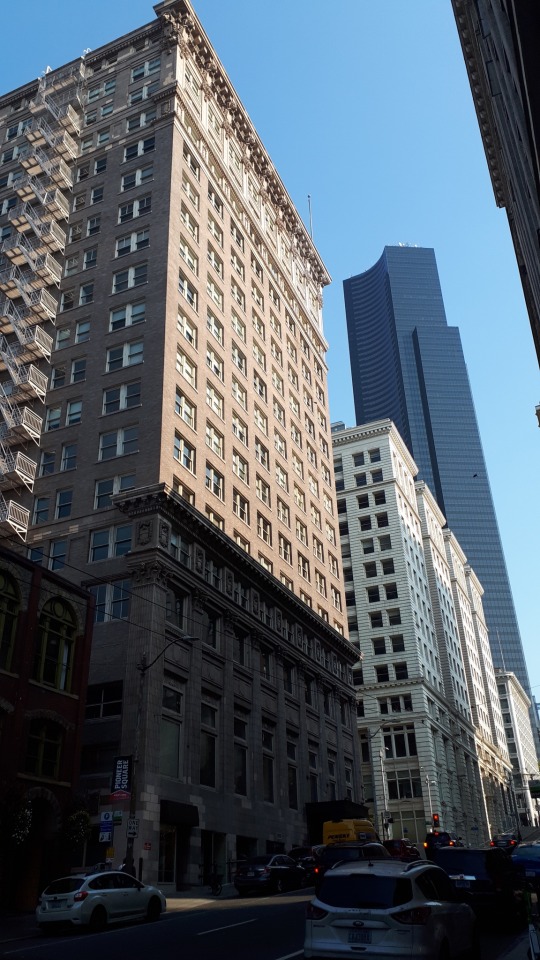
4 notes
·
View notes
Photo

Our artist of the day is @cassandralkim! We just released these two awesome small works in honor of her day. Cassandra Kim is a contemporary artist whose paintings reflect a lifelong love of animals and traditional art. Inspired by the master painters of the past and she seeks to put her own slightly absurd surrealistic twist on art by replacing animals with people. She also has been teaching herself to restore reclaimed antique and vintage wood items to paint on or frame her paintings in. She is a Virginia native and 2003 BFA Illustration graduate from Virginia Commonwealth University, and worked as a muralist and graphic artist for Trader Joes for 14 years. In 2013, the Klondike Gold Rush National Park and Chilkoot Historical Site awarded Cassandra with an artist residency. In 2018 Cassandra turned her focus to her personal art full-time. She has been in exhibits across the United States and internationally. #meartistoftheday #mesummertour https://www.instagram.com/p/Cf4Fl3hrtbf/?igshid=NGJjMDIxMWI=
2 notes
·
View notes
Photo

It is an honor, every year, to walk in the Seattle Pride Parade, spreading the message that "Parks are for Everyone!" We've been sidelined for two years due to the Pandemic, but this year's event was colorful, chaotic, and joyful, with huge crowds both marching in the parade and watching from the sidewalks on a hot, sunny day. Mount Rainier National Park's contingent was joined by rangers and volunteers from Olympic National Park, Klondike Gold Rush National Historical Park - Seattle, WA, the NPS Seattle Support Office, and Olympic National Forest. We handed out #RangerPride stickers to hundreds of people and were cheered enthusiastically all along the route. See for yourself! Photos are at https://flic.kr/s/aHBqjzW5J5.
Next up is the Eatonville 4th of July Parade! As always, volunteers are welcome to join us in representing Mount Rainier National Park in this gateway community. If you'd like to walk with us at noon on July 4th, please RSVP to [email protected] for details.
#Seattle Pride#PrideFest#Mount Rainier National Park#volunteer#Ranger Pride#Olympic National Park#Klondike Gold Rush#Olympic National Forest#US Forest Service
2 notes
·
View notes
Photo
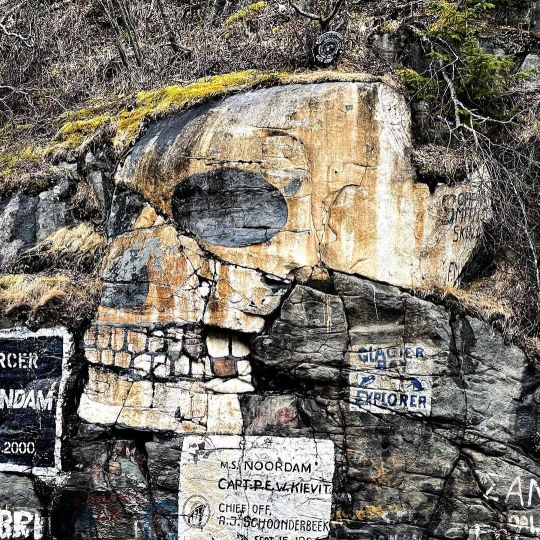
Familiar Faces and Buildings - Return to Skagway, Alaska- Beside the Railroad Dock in Skagway is a cliff upon which are painted the names of ships and when they first arrived in Skagway. This ships' registry has been used to announce the first arrival of ships for over one hundred years. In addition to ship names, there is a large skull painted on the rock face that is labelled "Soapy Smith's Skull." Soapy was one of the original con men and criminals who arrived to prey upon unsuspecting miner in town for the Klondike Gold Rush. Also shown here are details of Arctic Brotherhood Hall, 245 Broadway, Skagway, Alaska. This fascinating façade has nearly 9,000 small pieces of driftwood assembled into a checkerboard design. Camp Skagway No. 1 was a brotherhood of gold speculators and miners. It was established in 1899 when approximately 600 men a day arrived in Skagway by steamers from Seattle. This was the first of eventually thirty camps or brotherhood halls created in Alaska and neighboring Canada. At the peak of the Klondike Gold Rush, membership exceed 10,000 prospectors. -Round Circle is from the door of Alaska's first Y.M.C.A. Circa 1900. Skagway's boom was short lived for this building was closed with the decline of the gold rush in 1901 converted to the Arctic Meat Company and then abandoned. Currently in the process of been stabilized and restored. 5th Avenue and State Street, Skagway, Alaska Source: Klondike Gold Rush National Historic Park, National Park Service, US Department of the Interior, sign on site. & Wikipedia #Alaska #travel #wanderlust #globalgypsy #cruiseship #details #seaman #architecture #godisinthedetails #wandering #details #traveladdict #travelbug #portofcall #traveladdicts #traveladdiction #FotoQuartet #worldtraveladdict #awesome #adventurist #Skagway #adventure #USA #Alaska #SGY #ArcticBrotherhoodHall #CampSkagwayNo1 (at Skagway, Alaska) https://www.instagram.com/p/CdJ9FNVpVhs/?igshid=NGJjMDIxMWI=
#alaska#travel#wanderlust#globalgypsy#cruiseship#details#seaman#architecture#godisinthedetails#wandering#traveladdict#travelbug#portofcall#traveladdicts#traveladdiction#fotoquartet#worldtraveladdict#awesome#adventurist#skagway#adventure#usa#sgy#arcticbrotherhoodhall#campskagwayno1
2 notes
·
View notes
Link
#tpo 10#riverboat discovery in fairbanks#kenai fjords national park#juneau#Denali National Park#ketchikan#klondike gold rush national historical park#alaska railroad#seward alaska#iditarod national historic trail#wrangell-st. elias national park & preserve#alaska
1 note
·
View note
Photo




Michael J. Heney: The Irish Prince
October 24, 1864- October 4, 1910
The Klondike Gold Rush (1897-1898) was one of the last major gold rushes in North America. The discovery of gold along the Rabbit Creek sparked an influx of fortune seekers to the interior of Canada. Pierre Berton’s Klondike Fever estimates that 100,000 transient men and women made their way to the fields through Dyea and Skagway, Alaska, over the Chilkoot and White Pass trails.
A trail, road, and tramway were developed in a span of a year to ease the congestion of people and pack animals that attempted this journey. All of these transportation systems failed; however, a successful transportation route was developed thanks to the ingenuity and expertise of Michael J. Heney, the “Irish Prince.”

Michael J. Heney was born in 1864 to Irish immigrant farmers in Ontario, Canada. At the young age of 14, he ran away from the family farm to work for the Canadian Pacific Railway (CPR) in British Columbia, Canada. An older brother found him and brought him home. He stayed in Ontario working on the farm until he was 17 when he left again to work for the CPR. Heney started working as a mule-skinner before he progressed to laying rails.
In 1883, he started working on a surveying crew in Frasier River, B.C., which he worked with for the next two years. His goal, ultimately, was to learn as much about the construction of railroads as possible. When the railroad was complete, he made the decision to pursue a degree in engineering so that he could become an independent contractor. After finishing school, he went back to work for the CPR. In 1896, he came to Alaska to work on a project at Anchor Point (located on the Kenai Peninsula), sparking his interest in the north.
A short time after the Anchor Point project, in March 1898, Heney traveled to Skagway, Alaska, to conduct a preliminary search of the White Pass Trail. He believed a successful railway could be constructed over the pass. By happenstance, Heney met two engineers from a bank in London, Close Brother and Company, who were assessing the pass and determining if a railroad was feasible. They had decided it was not; enter Heney, who convinced them otherwise.
They developed a plan to construct the railway using a narrow gauge system, which was able to handle the steep terrain of the White Pass. Heney was initially labor foreman, but eventually became the contractor on record for the last two-thirds of the railways construction.

On June 15, 1898, Michael Heney authorized the ground breaking of the White Pass and Yukon Route (WP&YR) railway, beginning at Broadway in Skagway. Heney supervised a crew of a 1,000 men and set up crews that worked around the clock during the summer. He would travel between camps by horse to check progress; he set up a cot at every camp along the route for this purpose.
The placing of the route required steep grading, switchbacks, and blasting of rocks. The construction itself was a dangerous feat. He oversaw the construction through harsh winds, snowstorms, a labor strike, and the desertion of crews for the gold fields. Overall, Heney managed an estimated 35,000 workers who constructed the 110.6-mile railway in less than three years at the cost of $10 million. The WP&YR railway, completed at Whitehorse, Yukon, Canada, on July 29, 1900, reconfigured the transportation network between Alaska and the Yukon.

Michael Heney pursued another opportunity in the Copper River Valley in 1901 after completing the WP&YR railway. The Kennecott Copper Corporation was looking for a route to transport ore and supplies from their large mining operation, Kennecott Mines, Alaska. Heney surveyed the area, and determined that the best route was from Kennecott to Cordova; however, the Kennecott Copper Corporation did not agree and began establishing a different route.
Heney founded the Copper River Railway Company, with the backing of the Close Brothers and Company, to begin construction on his railroad in April 1906. In the meantime, the Kennecott Copper Corporation began construction on their railway, originating in Valdez, Alaska. They soon realized their choice was not feasible, and hired Heney to complete the railway following his route, which was completed in 1909, creating the Copper River and Northwestern Railroad.
Michael J. Heney’s railroad construction skills contribute to two of Alaska national parks, Klondike Gold Rush National Historical Park and Wrangell-St. Elias National Park and Preserve (WRST). Though the railroad is no longer extant in WRST, visitors to the park travel the historic railbed into the interior of the park, which terminates at Kennecott Mines National Historic Landmark.

Sources:
Gilbert, Cathy, Paul White, and Anne Worthington. “Kennecott Mill Town Cultural Landscape Report,” Anchorage, AK: National Park Service, Alaska Regional Office, 2001.
Matthews, Laurie and Edward San Filippo. “White Pass Historic Transportation System Cultural Landscape Report-Draft,” Skagway, AK: National Park Service, Klondike Gold Rush National Historical Park, 2017.
Minter, Roy. “HENEY, MICHAEL JAMES,” Dictionary of Canadian Biography, vol. 13. University of Toronto, 2003. Accessed February 2017. http://www.biographi.ca/en/bio/heney_michael_james_13E.html.
#Alaska#National Park Service#Irish History#Cultural Landscape#Klondike Gold Rush National Historical Park#Wrangell-St. Elias National Park and Preserve
19 notes
·
View notes
Text
Amazing Adventures - Alaska
This blog post shares UPDATED Travel Destination Guide: Amazing Adventures Alaska. Here discover the highest mountain in North America, railways, ice museums and so much more. Let's travel Alaska style!
Hello and welcome to my UPDATED Travel Destination Guide: Amazing Adventures – Alaska. Come explore with me and discover the highest mountain in North America. Aurora’s Ice Museum/Bar/Hotel and so much more. Let’s travel Alaska style.
Mountains and Glaciers and Trains – Alaska
The Denali Mountain range (formerly known as Mount McKinley) is the highest mountain peak in North America. The summit…
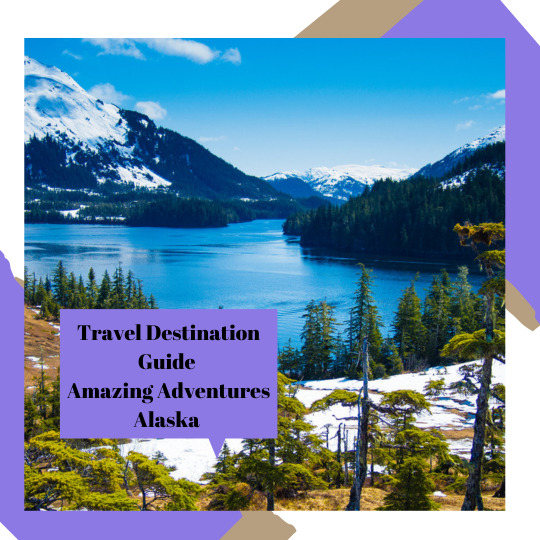
View On WordPress
#A Few of my Favorite Things#Alaska Lifestyle#Amazing Adventures#Amazing Travel#Amazing Travel Adventures#Aurora Ice Museum#Denali Mountian#Glacier Bay National Park and preserve#Klondike Gold Rush#Klondike Gold Rush National Historic Park#Mount McKinley Mountain#New Blog Post#Riverboat Discovery Tours#Things to do in Alaska#Travel Adventures#Travel Destination Guide#White Pass & Yukon Route Railway
0 notes
Link
1 note
·
View note
Photo
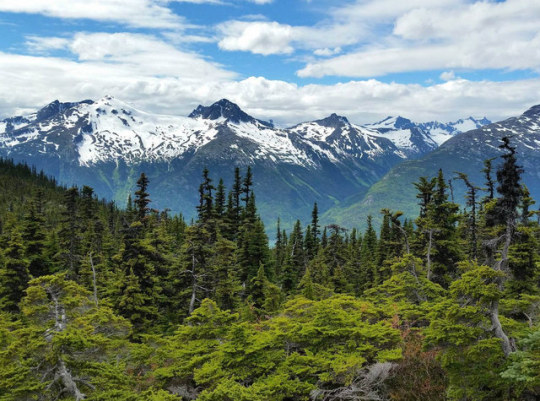
In the last four years of the 19th century, over 100,000 prospectors flooded into the Klondike region of Alaska and Canada looking for gold. Klondike Gold Rush National Historical Park not only tells the stories of these pioneers, it preserves 13,000 acres of historic sites and stunning wilderness. Traveling the trails is like going back in time. Photo by C. Anderson, National Park Service.
#klondike gold rush#klondike goldrush national historical park#national park service#nps#find your park#findyourpark#Alaska#usinterior#history#nature#nature photography#landscape#landscape photography#trees#mountains#Forest#wilderness#amazing view#awesome experience#gorgeous scenery#outdoors#great outdoors#america's great outdoors
1K notes
·
View notes
Text

Historic photo from Pioneer Square about 1897 (NPS Brochure on the Gold Rush Museum)

Pioneer Building at Pioneer Square. 48 mining firms flourished here because of the Gold Rush
Pioneer Square close to the harbour in Central Seattle contains many historic buildings. I was glad that we managed to go to the Klondike Gold Rush Museum. The exhibition was engaging as you followed different historical persons who took part in the gold rush or earned money on equipment for the journey to Alaska.

Routes to the Klondike by water, by water and land and overland through Canada
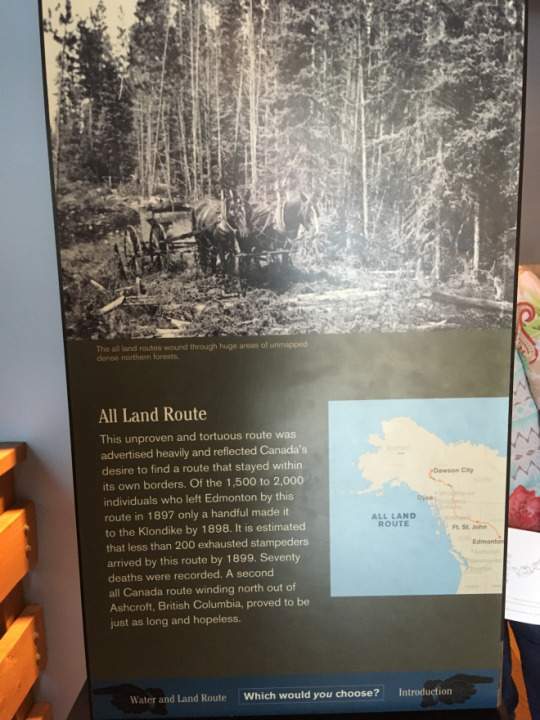
A picture showing the land route to Yukon, Alaska
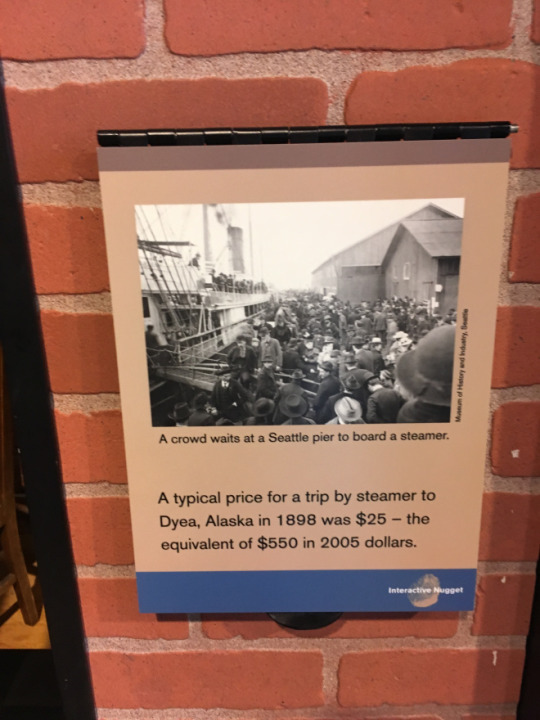
A crowd waiting to board a steamer

From a brochure: The Klondike Gold Rush Museum in Historic Cadillac Hotel at S Jackson and 2nd Av, Seattle

Exhibition case at the Gold Rush Museum
Advertisement for buying mining equipment at Cooper & Levy
Mining the Miners. Get everything you need at Cooper & Levi
A supply list for your mining equipment
A supply list for your mining equipment
Exhibition case at the Gold Rush Museum
Get your Klondike gear here at the lowest price
Very few people got rich from digging gold. It was already over when the big rush arrived.

Photos showing shops for gold mining equipment and a government office making gold bars.

Erastus Brainerd promoted Seattle as a gateway to the Klondike.
Two men stood out to me. One was Erastus Brainerd who understood the value of the advertisement. Seattle was not the most obvious way to chose to go to Alaska, but he travelled all over the United States and succeeded to guide people to go to Seattle to buy the equipment for the challenging journey. From the Klondike Goldrush Museum’s Homepage:
Seattle merchants quickly exploited their port status. Advertisements far and wide declared Seattle as the “Gateway to the Gold Fields” – the place where all one’s Klondike needs, from food and warm clothing to tents and transportation-could easily be fulfilled. As a result, some 30,000 to 40,000 of the estimated 70,000 stampeders, who outfitted to go to the Klondike, bought their “ton of provisions” in Seattle. The city prospered.
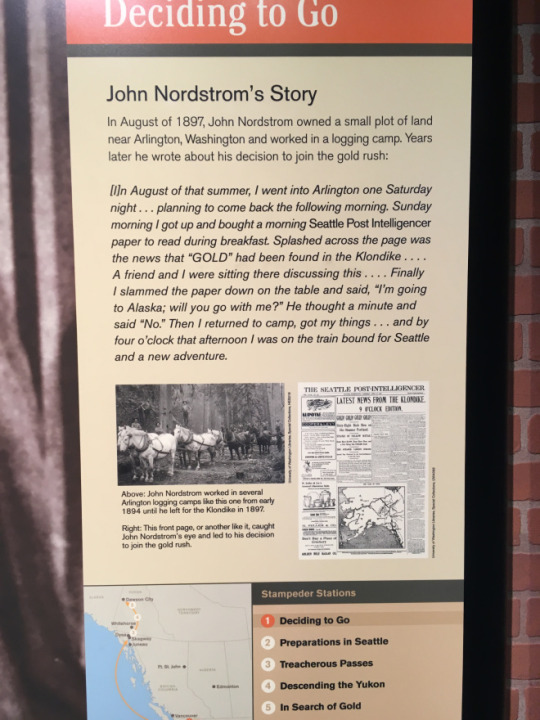
Swedish John Nordstrom’s story from working at a logging camp to becomig a gold miner.
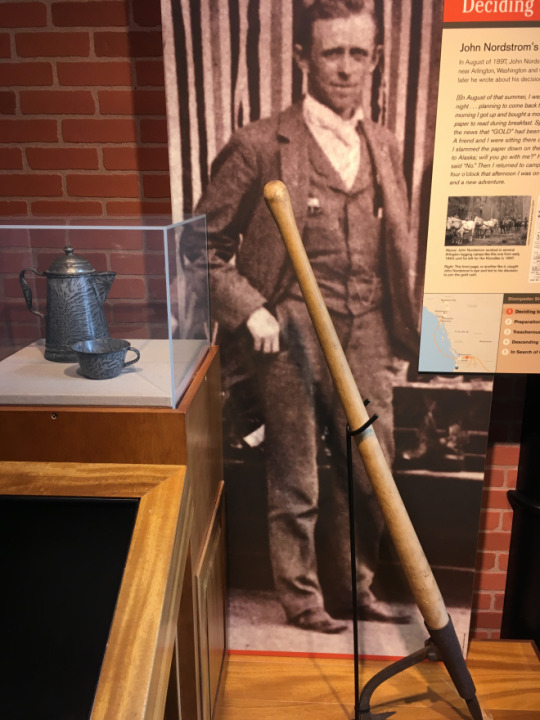
A photo of John Nordstrom
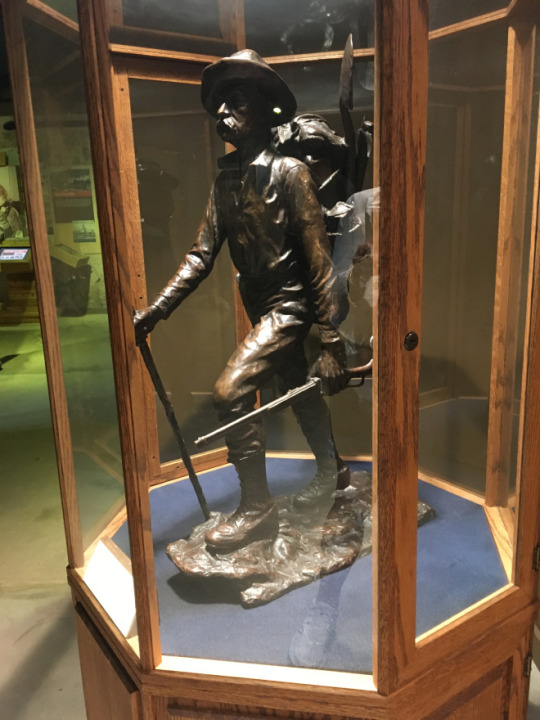
Bronze statue of a gold miner at the Gold Rush Museum
John Nordstrom, a young man from Sweden who at the age of sixteen in 1887, left his homeland to start a new life in the USA. One day at work in 1897, he read about the Gold Rush and decided to go the next day. He did earn some money from gold-digging but sold his part due to a dispute and started a shoe shop with someone in Seattle.
Nordstrom’s shoe shop developed into a department store that still flourishes in many places in the Western part of the United States. I later enjoyed shopping in Nordstrom’s in Portland, Oregon. His store is known for high customer service.
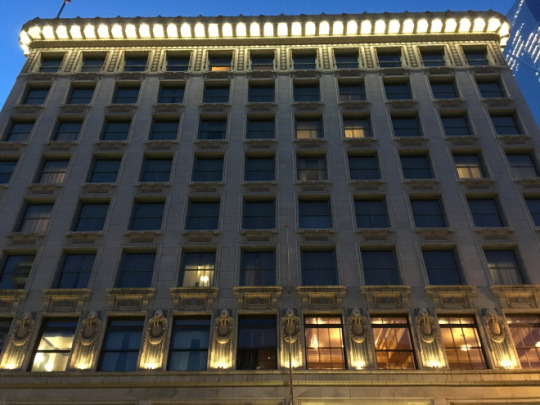
The Arctic Club Building Seattle Landmark. Contractor Hans Pederson
I have a blogging friend Paula Pederson whose father Hans Pederson from Denmark (1865-1933), was one of the great builders of Seattle at the same time as John Nordstrom. Before Hans Pederson found his destiny in the building business, he nearly lost his life in the gold rush. You can read more about him on Paula’s blog and the book she wrote about him. He got his breakthrough in 1904 with the contract to plaster the Alaska Building.
From Hans Pederson’s obituary:
“He was among the first to answer the call of the North when the manhood world stampeded toward the artic and the sparkle of gold.”
Few women and children made it to the Yukon area in Alaska. Ethel Anderson was born in Bellingham, WA but spent her first six years in a cabin on Eldorado Creek in Yukon.
She later achieved to gather treasure of long-forgotten photographs from the adventure.

Ethel Anderson managed the harsh journey to Yukon with her mother and a sibling. Her red coat is on display
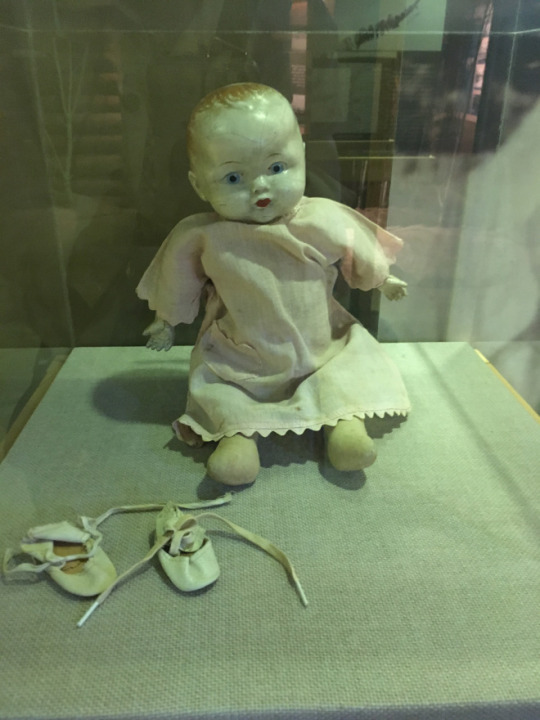
Ethel Anderson’s doll from her early childhood in Yukon
The Klondike Gold Rush Museum in Seattle Pioneer Square close to the harbour in Central Seattle contains many historic buildings. I was glad that we managed to go to the Klondike Gold Rush Museum.
0 notes
Text


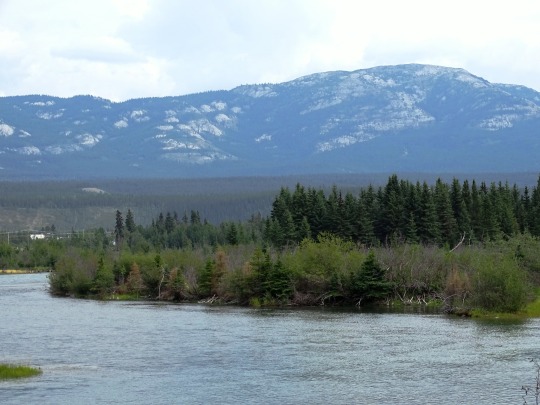

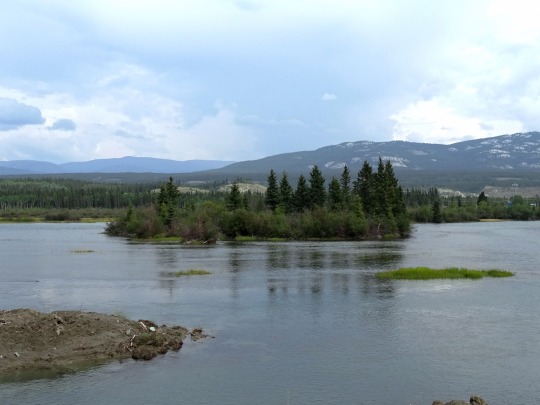

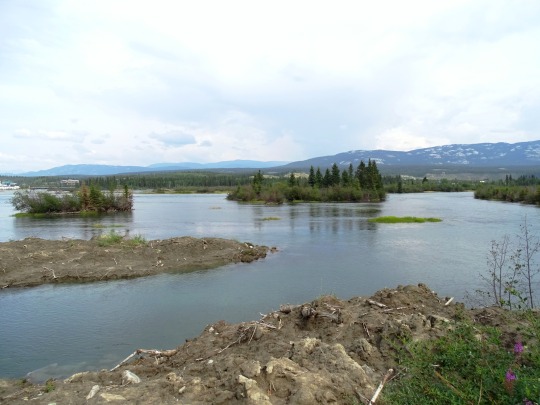
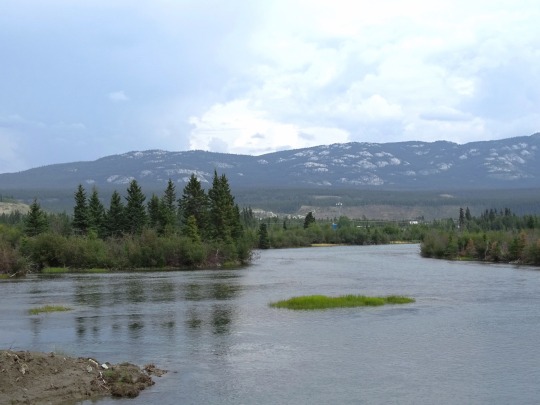
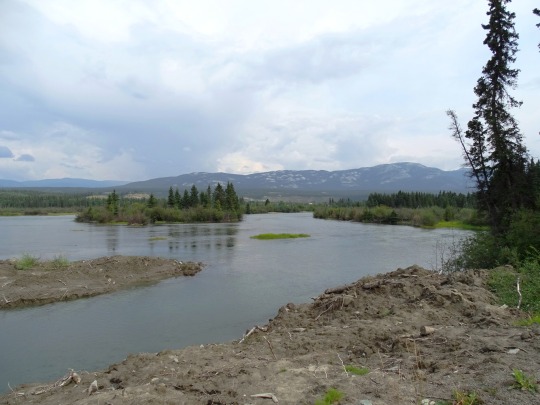
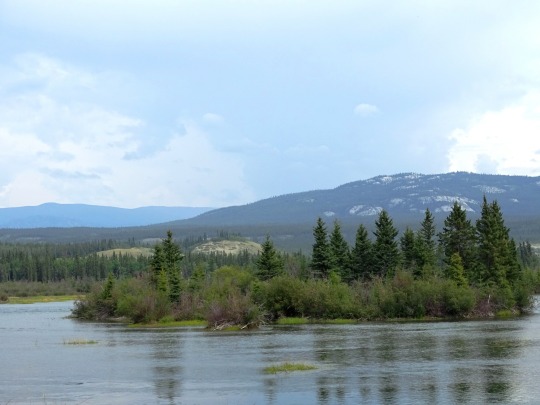
Yukon River, Whitehorse (No. 1)
The Yukon River is a major watercourse of northwestern North America. From its source in British Columbia, Canada, it flows through Canada's territory of Yukon (itself named after the river). The lower half of the river continues westward through the U.S. state of Alaska. The river is 3,190 kilometres (1,980 mi) long and empties into the Bering Sea at the Yukon–Kuskokwim Delta. The average flow is 6,400–7,000 m3/s (230,000–250,000 cu ft/s). The total drainage area is 833,000 km2 (321,500 sq mi), of which 323,800 km2 (125,000 sq mi) lies in Canada. The total area is more than 25% larger than Texas or Alberta.
The longest river in Alaska and Yukon, it was one of the principal means of transportation during the 1896–1903 Klondike Gold Rush. A portion of the river in Yukon—"The Thirty Mile" section, from Lake Laberge to the Teslin River—is a national heritage river and a unit of Klondike Gold Rush International Historical Park. Paddle-wheel riverboats continued to ply the river until the 1950s, when the Klondike Highway was completed. After the purchase of Alaska by the United States in 1867, the Alaska Commercial Company acquired the assets of the Russian-American Company and constructed several posts at various locations on the Yukon River.
The Yukon River has a recent history of pollution from military installations, dumps, wastewater, and other sources. However, the Environmental Protection Agency does not list the Yukon River among its impaired watersheds, and water-quality data from the U.S. Geological Survey shows relatively good levels of turbidity, metals, and dissolved oxygen. The Yukon and Mackenzie rivers have much higher suspended sediment concentrations than the great Siberian Arctic rivers.
The Yukon River Inter-Tribal Watershed Council, a cooperative effort of 70 First Nations and tribes in Alaska and Canada, has the goal of making the river and its tributaries safe to drink from again by supplementing and scrutinizing government data.
Source: Wikipedia
#Whitehorse#Yukon#travel#original photography#vacation#tourist attraction#landmark#cityscape#landscape#Yukon River#summer 2023#woods#forest#flora#nature#mountains#the North#fireweed#widlflower#river bank#Canada#architecture#SS Klondike#clouds
8 notes
·
View notes
Photo
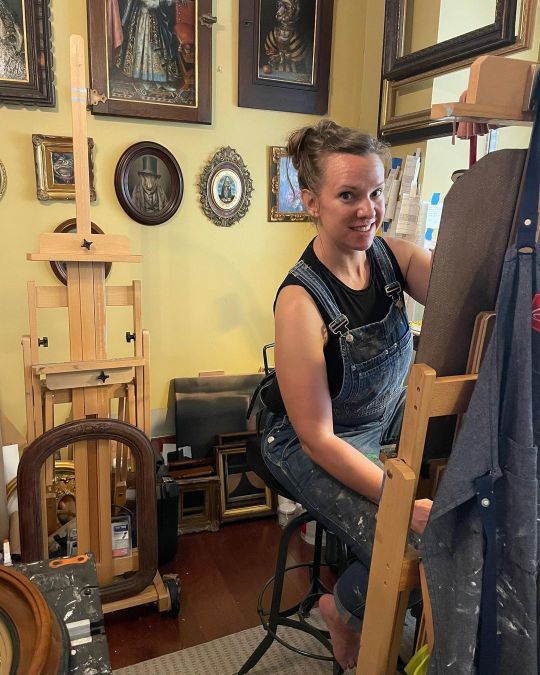
Tomorrow’s artist of the day is Cassandra Kim! ⭐️ Cassandra Kim is a contemporary artist whose paintings reflect a lifelong love of animals and traditional art. Inspired by the master painters of the past and she seeks to put her own slightly absurd surrealistic twist on art by replacing animals with people. She also has been teaching herself to restore reclaimed antique and vintage wood items to paint on or frame her paintings in. She is a Virginia native and 2003 BFA Illustration graduate from Virginia Commonwealth University, and worked as a muralist and graphic artist for Trader Joes for 14 years. In 2013, the Klondike Gold Rush National Park and Chilkoot Historical Site awarded Cassandra with an artist residency. In 2018 Cassandra turned her focus to her personal art full-time. She has been in exhibits across the United States and internationally. @cassandralkim #meartistoftheday #mesummertour (at Virginia) https://www.instagram.com/p/Cf23P_YLBN5/?igshid=NGJjMDIxMWI=
0 notes
Text




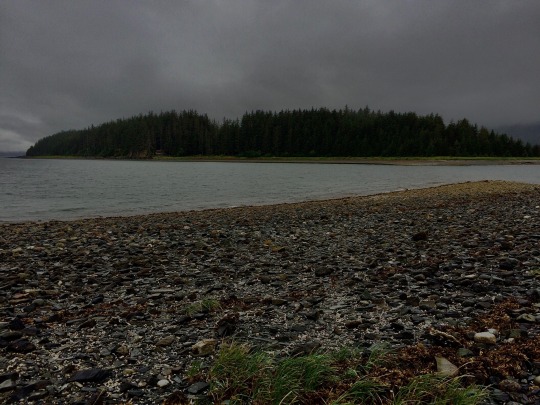
Klondike Gold Rush National Historical Park, Skagway, Alaska. & Colt Island, Alaska.
2 notes
·
View notes
Photo

Local Skagway, Alaska artist Peter Luchetti created the sculpture shown here that was inspired by the words of stampeder Mont Hawthorne. When have you felt like giving up and sitting down? What helped you get back up and continue? "We walked along in the snow, and we come to a fellow sitting on the back of a Yukon sled. Yep, he was just setting there in the middle of the road, talking to hisself. His head was down in his hands. He looked plumb played out. He never seen us; he just went on talking to hisself. Over and over he'd say: It's hell. It's hell.” The Trail Led North: Mont Hawthorne's Story Klondike Gold Rush National Historical Park • National Park Service • Department of the Interior Sculpture located next to Alaska Geographic Building 157 2nd Ave, Skagway, Alaska. Source: Sign on site #travel #wanderlust #globalgypsy #cruiseship #details #seaman #wander #thedevilisinthedetails #NationalParkService #NationalPark #godisinthedetails #wandering # #portofcall #KlondikeGoldRush #KlondikeGoldRushNationalHistoricPark #Skagway #adventure #USA #Alaska #SGY #FotoQuartet (at Skagway, Alaska) https://www.instagram.com/p/CfOGJB_OxlQ/?igshid=NGJjMDIxMWI=
#travel#wanderlust#globalgypsy#cruiseship#details#seaman#wander#thedevilisinthedetails#nationalparkservice#nationalpark#godisinthedetails#wandering#portofcall#klondikegoldrush#klondikegoldrushnationalhistoricpark#skagway#adventure#usa#alaska#sgy#fotoquartet
1 note
·
View note
Text



Why do you want to visit Mount Rainier National Park?
Is it for our fabulous Cascade Concrete, aka snow, so you can slide down the Snow Play sledding run?
Or maybe the wildflowers of July call you to hike the far reaches of the mountain’s sub-alpine parks?
Spring-time waterfalls are enchanting while you drive in the park with stops like Christine Falls.
And how about the park’s stunning historic districts?
*record scratch*
When you think history and National Park Service sites, places like Klondike Gold Rush National Historic Park – Seattle, WA or Ebey’s Landing National Historical Reserve come easily to mind. Mount Rainier has tons of history too. As one of the earliest national parks in the country, Mount Rainier came to define what a national park looks like. The roads, the buildings, the trails, etc. Many of our buildings, some roads, and even a trail or two (like the Wonderland Trail) are on national historic registries.
Preserving our history seems straight forward. Keep the buildings, roads, trails, etc., looking the way they did historically. That job falls on the park’s historical architect and landscape architect. In a way, the landscape architect, through reports and other documents, preserves our history in words. The rest of her job is preserving that history on the land. She makes sure that we keep Longmire, Paradise, the road to Paradise and many other things looking historically correct.
The cultural landscape reports are a big part of that, giving us an ideal to strive towards. Many are available on-line at IRMA (Integrated Resource Management Applications https://irma.nps.gov/Portal/ ) Just search for Mount Rainier and you can find the work and tools of our landscape architects over time. The history and photographs they put into the reports and inventories to protect our historic landscapes is pretty amazing.
Have you stopped and enjoyed the historic landscapes of Mount Rainier? ~ams
NPS/K. Loving Photo (top). View of Christine Falls and road bridge from view point. May, 2017. NPS Photos. Images of front of Longmire Developed Area Cultural Landscapes Inventory, and View and Vista Management Plan. Both available on-line at IRMA.
#encruentra tu parque#find your park#mount rainier national park#mount rainier#history#cultural landscape#landscape architect#NPS#Ebey's Landing NHR#Klondike Gold Rush NHP
35 notes
·
View notes